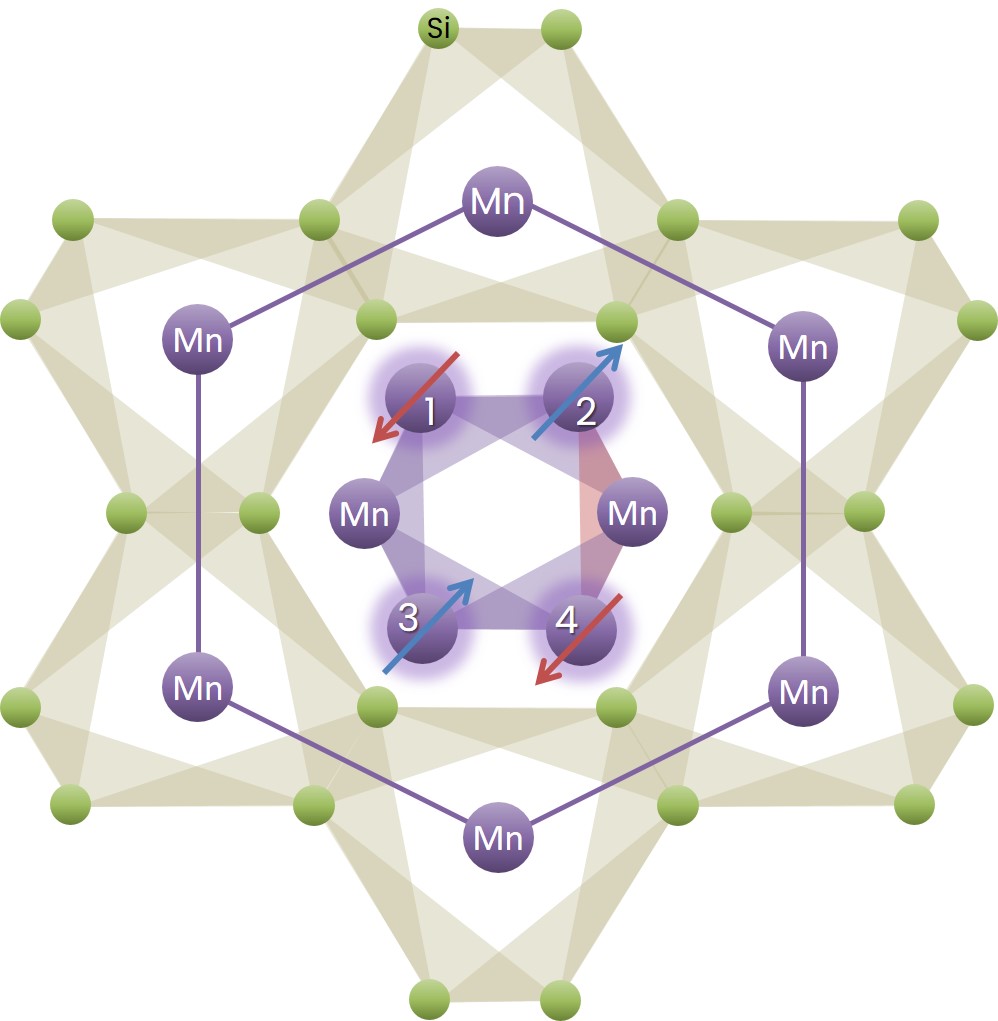There are two common types of magnetic materials. The first, ferromagnetic materials, have the ability to magnetize under the effect of an external magnetic field and to retain this magnetization; this is the case, for example, with pure iron, cobalt and nickel. They naturally have the ability to magnetically polarize an electric current passing through them.
The second, antiferromagnetic materials are composed of alternately opposite magnetic moments, so the resulting magnetization is zero. A priori, they do not magnetically polarize an electric current.
A recent discovery has revealed a third type of magnetic material known as
altermagnets. This new class of materials is very important: it is distinguished by the configuration of its spins, which gives it specific properties, such as the ability to magnetically polarize an electric current, despite the absence of magnetization.
For future applications, altermagnetism, by combining the advantages of ferromagnetism (spin polarization of an electric current) and antiferromagnetism (robustness to magnetic fields and response to ultra-fast THz frequencies), would enable us to produce spintronic devices with higher performance, because they are faster and denser.
To date, only four altermagnetic materials have been experimentally discovered: RuO2, Mn5Si3, MnTe and CrSb.
Researchers at IRIG [collaboration] have turned their attention to Mn5Si3, which possesses the altermagnetic character due to the positioning of its magnetic moments with respect to its crystalline symmetries (see
figure).
Moreover, this material has the advantage of being composed of abundant and inexpensive elements.
Guided by theoretical predictions and simulations, the researchers were the first to experimentally demonstrate the altermagnetic character of the Mn5Si3 material. This was revealed, on the one hand, by the presence of an
anomalous Hall effect: a magnetoresistive property typical of ferromagnets, since it is linked to the existence of a magnetization, whereas Mn5Si3 has no magnetization. In addition, the role of crystalline symmetries expected to explain altermagnetism has also been confirmed.

Figure : Crystal and altermagnetic structure of manganese silicide (Mn5Si3). Embedded in the crystal structure of silicon atoms (green), manganese atoms (violet) are distributed in a large hexagon and a small hexagon in the center. Researchers have shown that altermagnetism is produced by just four of the six central manganese atoms forming a set of collinear magnetic moments oriented alternately in opposite directions (red and blue arrows). The manganese atoms are linked by rotational symmetry due to the anisotropy of their non-magnetic environment. © [Collaboration]
This paper is a pioneer in the field, presenting experimental results obtained just one year after the theoretical prediction of altermagnetism. The discovery of the original altermagnetic character opens up a new field of investigation in materials physics. It has aroused great interest in the scientific community, which hopes to exploit altermagnetism for innovative developments.
Funds
Projects supported by ANR: ASTRONICS, MATHEEIAS
Project supported by CNRS: SPINMAT
Collaboration
- SPINTEC, University Grenoble Alpes, CNRS, CEA, Grenoble INP, Grenoble, France
- CINAM, Aix Marseille University, CNRS, AMUTECH, Marseille, France
- Universität Konstanz, Konstanz, Germany
- Institut für Festkörper- und Materialphysik and Würzburg-Dresden, Technische Universität Dresden, Dresden, Germany
- Institut für Physik, Johannes Gutenberg Universität Mainz, Mainz, Germany
- Institute of Physics, Czech Academy of Sciences, Praha, Czech Republic
- Department of Condensed Matter Physics, Faculty of Mathematics and Physics, Charles University, Praha, Czech Republic
An
altermagnetic material is composed of magnetic moments alternately oriented in opposite directions, as if it were a collinear antiferromagnetic material. Although devoid of magnetization, this material can nevertheless (under certain conditions) polarize an electric current flowing through it. Polarization is due to a shift between the electron bands of the majority and minority spins. Ferromagnetic, antiferromagnetic and altermagnetic crystals belong to three distinct symmetry subgroups. Unlike antiferromagnetic crystals, altermagnetic crystals do not have the same electronic environment, so they are linked by rotational symmetry rather than translational or inversion symmetry.
The
Anomalous Hall Effect describes to the appearance of an electrical voltage transverse to an electrical voltage and the resulting current. This voltage is induced by the presence of a magnetization in the material, without applying an external magnetic field as in the case of the conventional Hall effect.